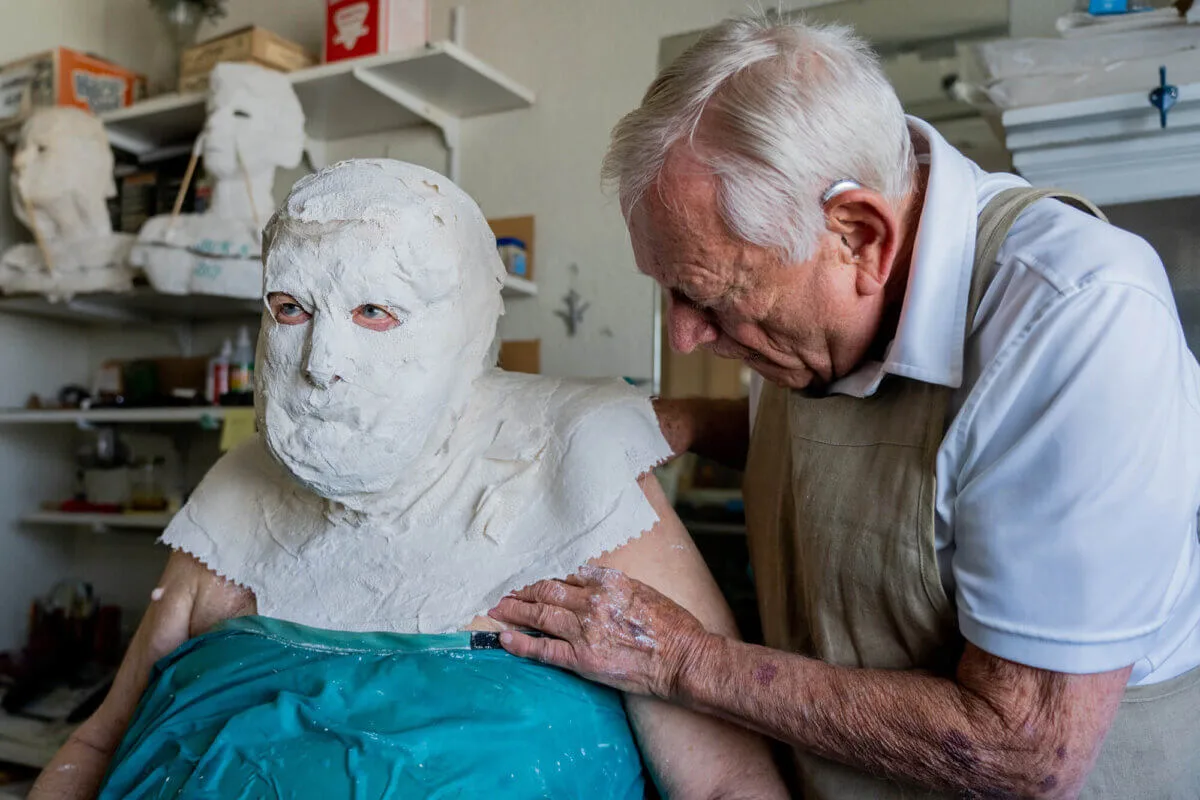
Robert Sutz begins to peel the mask away from Holocaust survivor Werner Salinger’s face at his art studio in Scottsdale on Feb. 12, 2022. (Photo by Samantha Chow/Cronkite News)
Along with casting their faces, Sutz captures his subjects’ stories on video and paints scenes they recall from the Holocaust.
SCOTTSDALE – “Would you like to breathe out of your nose or your mouth?” Robert Sutz asked.
“Either is fine,” replied Werner Salinger, a survivor of Nazi atrocities.
Sutz considered this for a moment, then reached for a plaster bandage, dunked it in water and laid it over Salinger’s lips. The Scottsdale artist continued applying the casting material until only Salinger’s bright blue eyes could be seen.
Forty-one minutes later, Sutz ran his fingers beneath the mold’s hardened edges and peeled it away from Salinger’s face, now preserved in a “life mask.”
Over the past 30 years, about 200 other “Holocaust survivors, liberators and righteous gentiles”—many of whom have since died—have sat in Sutz’s chair and had their faces preserved.
“It was cold, but I don’t mind cold, and it was wet,” Salinger said, laughing. “It wasn’t hurtful in any way, it was just another experience.”
Sutz will spend the next month or so painting Salinger’s mask to look lifelike – hence the name “life mask.
Along with casting their faces, Sutz captures his subjects’ stories on video and paints scenes they recall from the Holocaust—the genocide of an estimated 6 million people in Adolf Hitler’s “Final Solution” from 1941 to 1945.

Salinger’s story goes back to Kristallnacht, or the Night of Broken Glass, in 1938. On Nov. 9 and 10, Nazis torched and vandalized thousands of Jewish synagogues, homes, schools and businesses across Germany. About 100 people were killed and 30,000 Jewish men were arrested and sent to concentration camps.
“I remember very vividly the broken glass—I could see it from our apartment across the street—and the smoke from the burning synagogue was just a block away,” said Salinger, 89. “It was a very vivid memory for me; I was 6 years old.”
Roughly two months later, on Jan. 12, 1939, his family fled to the US.
“I’m doing this really for my parents,” Salinger said. “They would be very proud to know of my involvement today.”
Sutz, who is 92, said his inspiration for creating life masks comes from his father, President Abraham Lincoln and film director Steven Spielberg.

His father, who was Jewish, was born in Bialystok, Poland, but moved to Chicago when he was 12. Years later, when Hitler began his rise to power, Sutz’s father returned to Bialystok to warn his family and attempt to persuade them to move to the US, but they refused.
“They thought that Hitler was a crazy man and that people aren’t going to pay attention to him,” Sutz recalled.
So Sutz’s father packed up and returned to the US without them. The rest of his family later died in concentration camps.
Many years later, shortly after Sutz’s 13th birthday, he visited an exhibit where a life mask of Abraham Lincoln was on display.
“I got the chills because I felt his presence. It was something that really excited me,” Sutz said. “I told myself at an early age that I would like to learn how to make life masks.”
He eventually began making masks of family members, but it wasn’t until the 1990s that Sutz found a deeper purpose for creating life masks.
He came across an article in the Chicago Times recruiting people to join the visual history project run by Spielberg’s Shoah Foundation. Sutz was accepted into the group and went through a three-day training on how to interview Holocaust survivors.
Sutz then connected the dots and began making life masks of “Holocaust survivors, liberators and righteous gentiles,” as he puts it. Some of the first life masks in Sutz’s Holocaust collection came from doing these interviews.
“It’s a funny thing, I’m doing this now and Spielberg is unaware of what I’m doing, but he kind of introduced me to survivors,” Sutz said.
For nearly 20 years, Sutz took the masks on a traveling exhibit across the country, but eventually it became too difficult. Now, about 200 masks are in his art studio east of Old Town Scottsdale.

Sutz recently found a new home for his collection with the Arizona Jewish Historical Society—although it won’t be on display for at least a couple of years.
The society plans to build a museum to educate people about genocides throughout history.
“This would give people a place to go here locally to learn about the Holocaust (and) learn about other atrocities, as well,” said Lawrence Bell, director of Arizona Jewish Historical Society.
So far, the society has raised $5 million toward its goal of $15 million to build the museum. Bell said the goal is “to finish fundraising in 2023 and then maybe build it in 2024.”
Sutz’s life masks, along with some of his other Holocaust artwork, will be featured.
“I think the total grouping will just be awesome reminders that in one way shape or form these people went through some tough times,” Salinger said of the mask collection.
Sutz plans to keep creating life masks for as long as he can.
“I want to keep doing what I’m doing,” he said. “I just hope I can stay well enough to do more.”
Looking for the latest Arizona news? Sign up for our FREE daily newsletter.
Politics

6 terrifying things that could happen if the Comstock Act is used to target abortion
Does 1873 sound like a really, really long time ago? Well, that’s because it is—but if Republicans and far-right anti-abortion activists have their...

He said what? 10 things to know about RFK Jr.
The Kennedy family has long been considered “Democratic royalty.” But Robert F. Kennedy, Jr.—son of Robert F. Kennedy, who was assassinated while...
Local News

Opinion: Strategies for Child Abuse Prevention
11 ways you can be an ally in the fight against child abuse. April is Child Abuse Prevention Month. In the United States, it is estimated that a...

Biden marks Earth Day by announcing $7 billion in solar grants
The Biden administration on Monday announced the recipients of its Solar For All Program, a $7 billion climate program that aims to lower energy...




